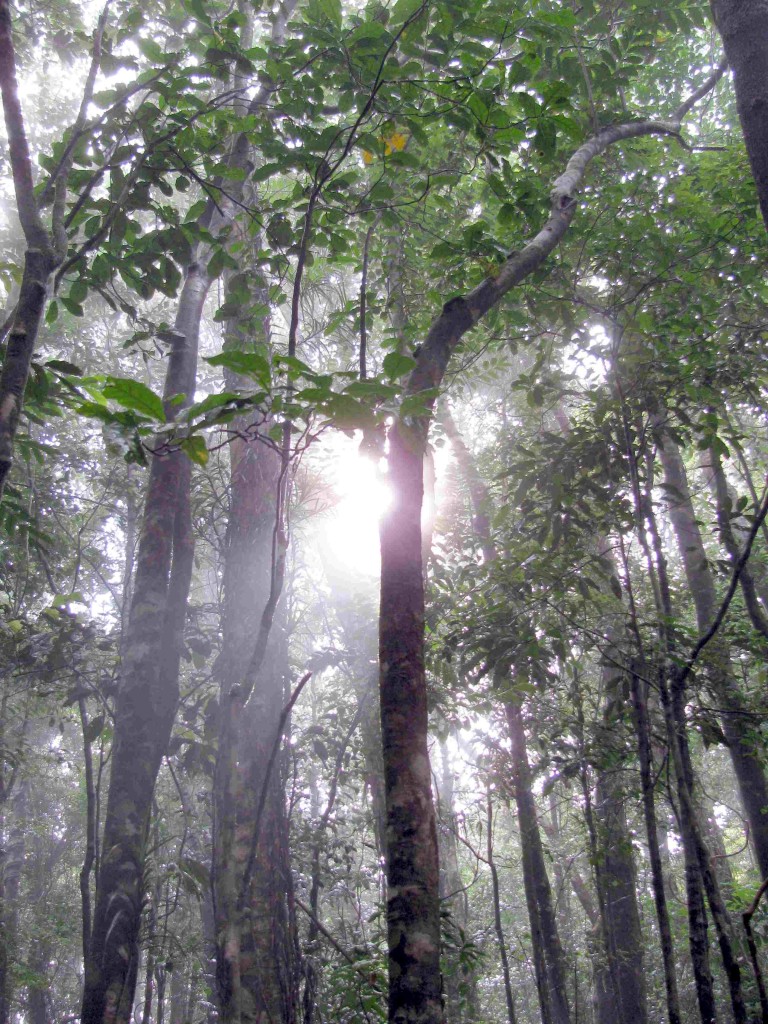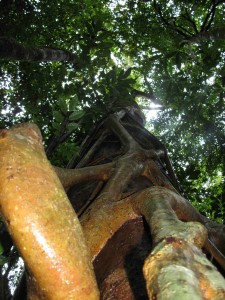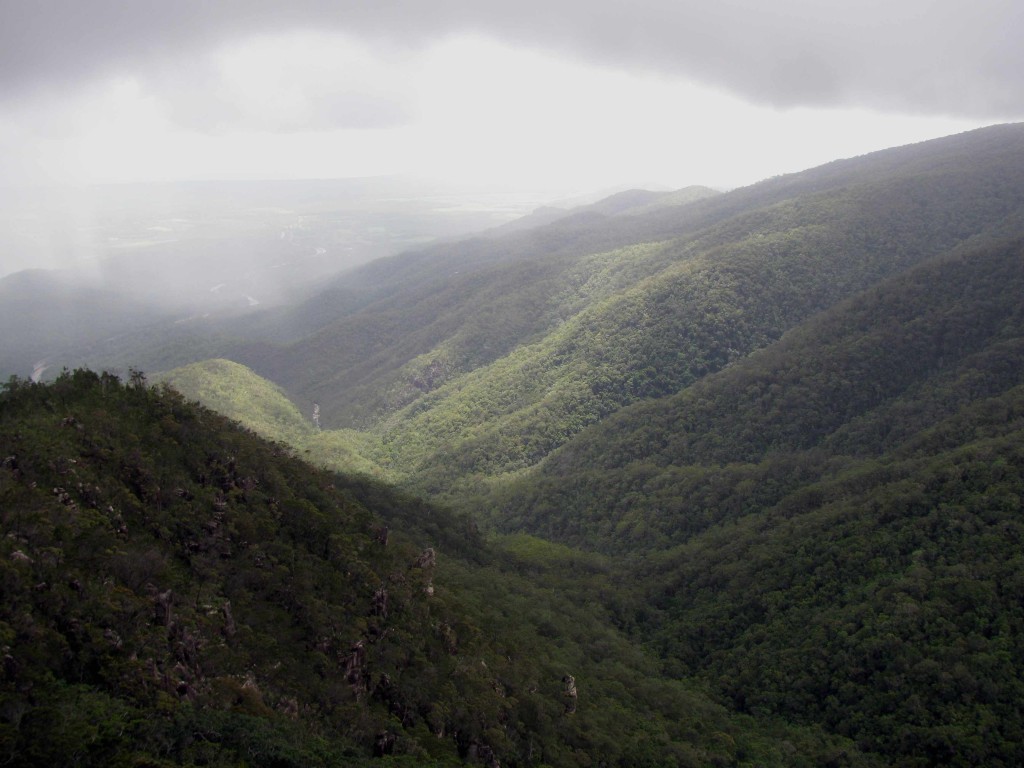
Paluma Wet Tropics Rainforest (© Vilis Nams)
At 7 a.m., Vilis and I hit the road for the rainforest village of Paluma about 80 kilometres northwest of Townsville, having decided to explore the rainforest tracks that we didn’t tackle on January 3. After heavy rain overnight, the sky was clear, with patches of cloud billowing upward and hanging over hills and peaks. On this trip, we spotted spiky, blue-green leaves of pineapple plants growing in fields near the Bruce Highway a few kilometres from the turn-off to Paluma Range National Park. Clumps of sugarcane in the fields bordering the park access road had grown taller and lusher.
Sunshine and tree shadows dappled the road on the steep slope of the mountain. While Vilis guided the Sportage around tight curves, I regaled him with my exclamations at having spotted grass-trees, cycads, rushing waterfalls, and massive granite outcrops in the savannah woodland on the lower slopes. All these had been blurred by heavy rain on our previous drive up the mountain, and during the drive down, I’d had eyes only for the views.
Higher on the mountain, where savannah woodland yielded to wet rainforest, mountain she-oaks draped slender, needle-like branchlets above the road. Two Australian brush-turkeys scurried into the forest from the road edge, and noisy pittas skimmed over the pavement, their blue-green and black plumages brilliant flashes of colour. Mist infiltrated the forest, and distant views so clear from lower on the mountain were obscured by cloud.
When we left the car, we sucked in lungfuls of cool, fresh mountain air so welcome after Townsille’s muggy heat. The forest was cluttered and noisy as before, but the coiling, entangling vines and chips, chirps, and bicycle-horn beeps seemed startlingly familiar, as if we’d returned to a place we’d once known well.
After our first visit to Paluma, I asked Chris Johnson, Vilis’s research colleague at James Cook University, what generated the waves of noise in the rainforest – insects, birds, tree frogs? His answer was, “All of those.” Today, we heard a new sound, the deafening warbles and clucks of a male chowchilla – a plump, foot-long ground-bird with a dark brown back, white belly, and pale eye-ring – singing on a fallen log. His volume would have made opera singers envious.
While hiking to Witt’s Lookout and then to Cloudy Creek, we spotted several groups of chowchillas scratching in leaf litter and skittering across the forest floor. Females resembled males, with the exception of an eye-catching rusty-orange throat. An immature male’s plumage was a messy collage of rusty-brown juvenile feathers mixed with the dark brown and white of adulthood. The birds’ dark backs blended in perfectly with the dark, rotting logs and decomposing leaves of the rainforest floor.

Vine Knot in Paluma Rainforest (© Vilis Nams)
Both Vilis and I were again struck by the prominence of vines in the forest. One spiraled around a slender sapling and then, as though having sensed a larger tree nearby, coiled upward around a thicker trunk. Another displayed a perfect knot, and Vilis speculated that someone had tied it that way when it was young. Trees of every size were gripped and hugged by thin, medium-sized, or thick vines that, in some cases, formed intertwining nets around trunks.

Strangler Fig on Host Tree (© Vilis Nams)
An interpretive sign explained that many ‘strangler figs’ are native fig species which have their seeds dispersed by frugivorous (fruit-eating) pigeons. After passing through the pigeons’ digestive tracts unharmed, the seeds often land high in the treetops. There they sprout and grow, sending roots down to the ground. As the figs increase in size, they shade out the host tree’s leaves and wrap its trunk in a net of vines that constrict it and restrict the tree’s growth. Eventually, the host tree dies, ‘strangled’ by the fig battling for its place in the sun among the rainforest giants.
From Witt’s Lookout, we gazed out over rainforest-clad hills and a river winding its way through a valley patched with forest and agricultural fields, all the way to the ocean. Wisps of cloud drifted across the slopes of peaks, and we watched rain showers sweep across the valley and onto a majestic outcrop of grey cliffs towering above the surrounding forest. Stunted trees, shrubs, and grass trees grew among lichen-encrusted boulders backing the lookout, and a pair of white-cheeked honeyeaters foraged for nectar in the yellow, bottlebrush blossom of a banksia shrub.

View from Witt’s Lookout (© Vilis Nams)
Leaving this lookout, we tramped another kilometre and a half to cloudy Creek Lookout. A brush-turkey led us along a section of the path through dim, thick forest, and on a side trail my adventurous husband chose to follow, I collected a land leech on my ankle and ripped the bloodsucker off. As we neared the creek, the trail became a steep staircase of rock steps covered with wet, fallen leaves, which we descended carefully. At the edge of the creek, which cascaded down the hillside in a series of waterfalls, we sat on pink boulders, munched apples, and looked and listened for cassowaries. According to my bird guide, these huge, flightless birds prefer to muck about in rainforest clearings, at rainforest edges, and near rainforest streams.1 Apparently, they also boom thunderously and emit guttural coughs.1 This bird, I would like to see and hear.
When rain set in, we flicked open our umbrellas, finished our apples, and hiked back to the village through a downpour that instantly caused the light level to plummet in the forest and transformed sections of the trail into miniature lakes and streams. Later, while we lunched at the Rainforest Inn, Vilis asked the young waiter if it rained every day at Paluma. His response was yes, in the summer, but in the winter, Paluma’s weather is drier and cold. (Of course, this is Australian cold, we’re talking about.)
On the return drive to Townsville, we heard a fascinating ABC documentary that explained how Adelaide Zoo is helping to safeguard populations of endangered brush-tailed wallabies by removing very young joeys from their mothers’ pouches and placing them in the pouches of much more abundant yellow-footed rock wallabies, who then act as surrogate mothers.2 Not only does the zoo do this within itself, it also collects the endangered wallaby newborns from wild populations, pops them in an incubator, and flies them with all speed to their new moms.2 The aim of the program is to eventually facilitate the reintroduction of the endangered species back into suitable habitats.2 However, the neatest thing about the program is that the mom wallabies from which the babies are taken always have a spare embryo waiting inside their wombs, so when their newborns are removed, they give birth to another one in 30 days.2 Thus, the moms don’t lose their opportunity to reproduce; instead, the reproduction rate of this endangered species is actually increased.2
References:
1. Graham Pizzey and Frank Knight. The Field Guide to the Birds of Australia. 1997. Angus & Robertson, Sydney, p. 18.
1. ABC Radio National, The Science Show. The point of zoos – part 1, Adelaide Zoo. February 13, 2010. Accessed 23-Nov-2010. http://www.abc.net.au/rn/scienceshow/stories/2010/2814250.htm


